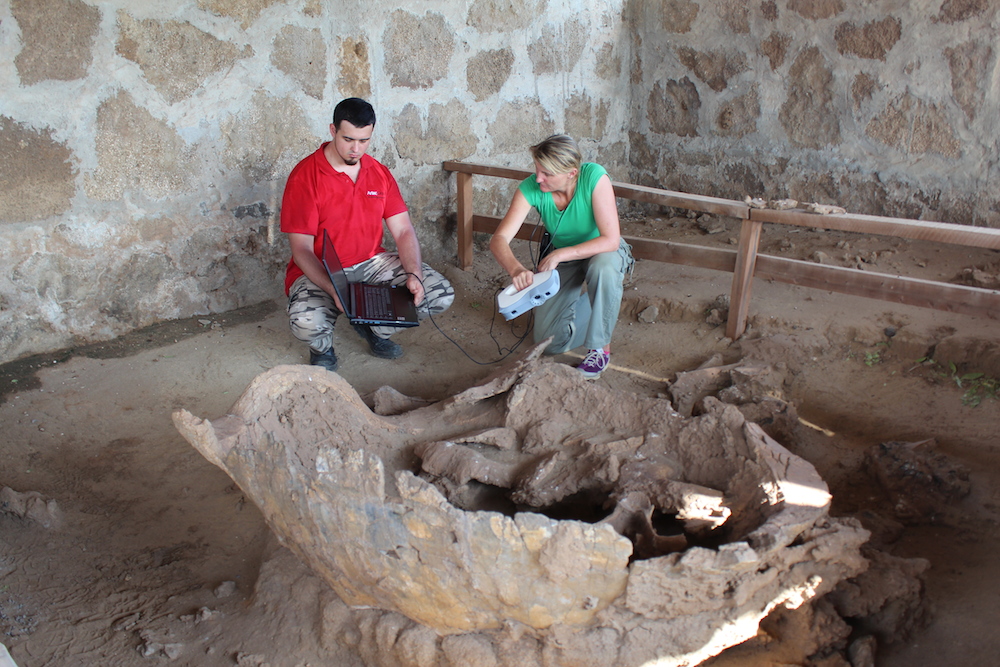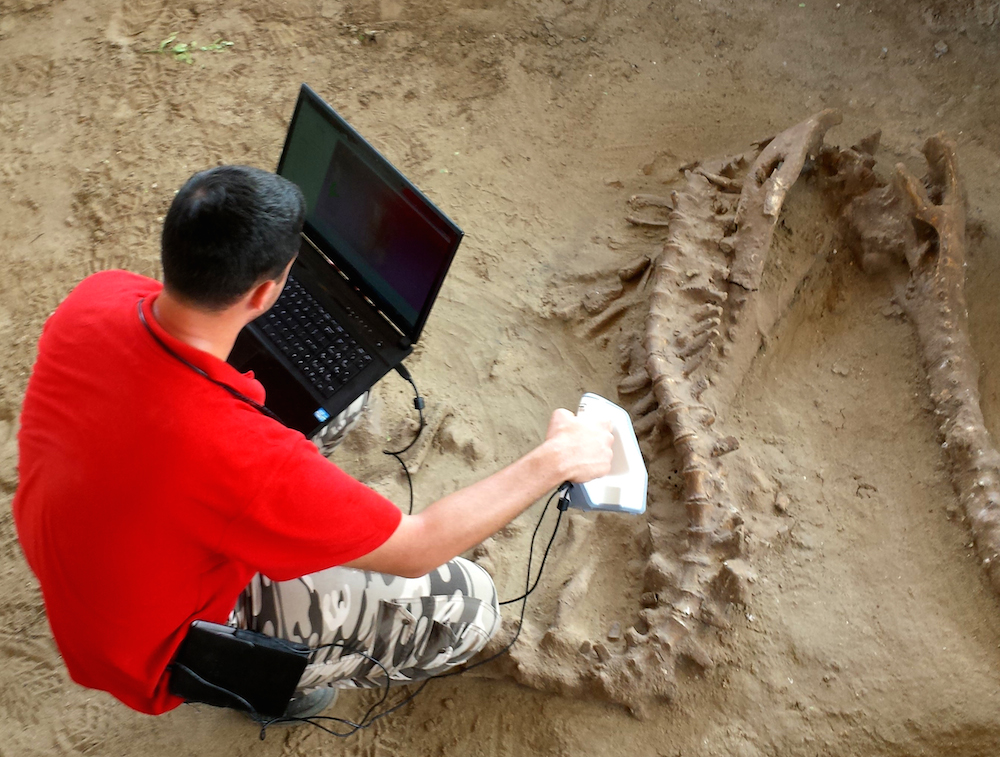Giant Fossils Get Renewed Life with 3D Scans

The cracked and broken bones of a 1.8-million-year-old crocodile, elephant and giant tortoise are now recorded in meticulous detail, thanks to cutting-edge 3D scanners.
When the bones were discovered at the Turkana Lake Basin in northern Kenya in the 1970s, they were in considerably better shape than they are now. But at the time, the fossils were too large to safely transport to Nairobi, a 3.5-day boat trip from the site.
Instead, the paleontologists who discovered them — the famous Leakey family — built enclosures for the fossils. "They had to be left there, so that’s why they were turned into these field exhibits so that people could see them there," said paleontologist Louise Leakey.
In September and October of this year, Leakey and her colleagues returned to the fossils to record their shapes with 3D scanners. They will put the scanned images online to share them with researchers and fossil enthusiasts the world over, saving them a trip to the remote Kenyan site. [In Photos: See Images of the Ancient Kenyan Fossils]
Over time, weather and vandals took their toll on the ancient remains, "so that’s why I was particularly eager to get the record or digital copy," Leakey told Live Science in an email.
On their trip, Leakey and her colleagues scanned two ancient crocodiles, a prehistoric elephant, a giant tortoise and countless other fossils — no small achievement, given that the team worked on days when temperatures reached 95 degrees Fahrenheit (35 degrees Celsius), and alongside large insects and scorpions at night, said Denis Baev, the head of the product requirements department at Artec, the company that donated the 3D scanners for the trip.
"The bugs were the most difficult part to deal with," Baev said. "You can't imagine how many bugs there were."
Sign up for the Live Science daily newsletter now
Get the world’s most fascinating discoveries delivered straight to your inbox.
Turkana treasure trove
For the Leakeys, paleontology is a family business. Louise's grandfather Louis Leakey helped determine that human evolution began in Africa. Her grandmother Mary discovered the preserved footprints at Laetoli in Tanzania, one of the oldest pieces of evidence of primate bipedal walking. Louise's parents, Richard and Meave Leakey, continued the family's fieldwork, especially at Turkana Basin.
It was in 1968 that Richard Leakey set up an expedition in northern Kenya, she said. One famous find was that of the 1.6-million-year-old Turkana boy, discovered in 1984 by Kamoya Kimeu, a fossil hunter who worked on Richard Leakey's team. Turkana boy was likely between 9 and 12 years old when he died.
"He obviously fell into a swamp, which is why his bones were so complete and they weren’t scavenged by animals," Leakey said.
Fossils at Lake Turkana are often fragmentary, making Turkana boy's near-complete skeleton a rare find that helped paleontologists learn about the body proportions, brain size and diet of his species. But the Turkana area has yielded countless other fossils, including those scanned on the latest trip. "There are literally fossils on the ground everywhere," Baev said.
Scanning spree
The scanners enabled the team to capture detailed, three-dimensional images of fossils before researchers attempt to move them to a more secure location, likely in Nairobi or the Turkana Basin Institute, a nonprofit research center founded by Richard Leakey and Stony Brook University in New York.
"Once you have a digital model, you can do comparisons of morphology, you can do comparisons of teeth, there’s any number of studies that can come out of it," Leakey said. [Image Gallery: 25 Amazing Ancient Beasts]
The 1.8-million-year-old elephant skeleton, discovered in 1974 by a team led by Richard Leakey, had a fairly complete skeleton, including the skull, two tusks, the mandible, limb bones, ribs, vertebrae and foot bones.
The elephant (Elephas recki) is an ancestor of the modern-day Asian elephant. The researchers used two three-dimensional scanners, "Eva," which provides a quick scan, and "spider," which can capture more detail.

"The mandible of the elephant was very well-preserved," Baev said. "We used spider to get as many details about the teeth as possible."
They also scanned a 1.8-million-year-old giant tortoise, found by Richard and Meave Leakey's team in the early 1980s, and excavated by Meave and her children, Samira and Louise, in 1984. The finding is one of the most complete fossils of a giant tortoise in Africa, Baev said.
"Actually, a human can take a bath in there," Baev said. "It's very big."
Vandals had damaged one of the two crocodile skeletons, possibly by throwing the head, Baev said. Some of its ribs, teeth and other bones are now missing or broken, he added. The scanner allowed the pieces to be digitally reconnected.
"I have used the software to connect these two pieces and to make them whole again," he said.
Another crocodile (Euthecodon brumpti) has a slender snout suited for eating fish, and also dates to 1.8 million years ago. Louise Leakey sacrificed her toothbrush to help clean the fossil before the scanning because the group had left their tools at camp, Baev wrote in his blog.
"For me it was amazing how great the condition of the fossil was," Baev told Live Science. "[But Louise] was actually quite mortified by its condition. She told me it used to be much better."
Louise Leakey said that the nearly complete crocodile skeleton was a find akin to Lucy, a key 3.2-million-year-old fossilized hominid found in Ethiopia in 1973.
"This is crocodile Lucy," she said. "And she was left in the field because she’s too big to move. She’s been very damaged over time — that’s why it was particularly important to get a scan."
For comparisons, at the Turkana Basin Institute the team also scanned the remains of modern animals, including a crocodile, giraffe, rhino, tortoise, buffalo and blue wildebeest. They also scanned hominid skull casts kept at the institute, including Turkana Boy, and 1.5-million-year-old Homo erectus footprints in Illeret, a village close to the institute.
On their last day at the institute, an archeologist who had just arrived from Nairobi happened upon the group.
"As he saw the 3D models, he was amazed," Baev said. "He said, 'But that means I don't have to travel this far to see the fossils.' I imagine that people from all around the world can take a look at all of the fossils we have uncovered."
Follow Laura Geggel on Twitter @LauraGeggel and Google+. Follow Live Science @livescience, Facebook & Google+. Original article on Live Science.

Laura is the archaeology and Life's Little Mysteries editor at Live Science. She also reports on general science, including paleontology. Her work has appeared in The New York Times, Scholastic, Popular Science and Spectrum, a site on autism research. She has won multiple awards from the Society of Professional Journalists and the Washington Newspaper Publishers Association for her reporting at a weekly newspaper near Seattle. Laura holds a bachelor's degree in English literature and psychology from Washington University in St. Louis and a master's degree in science writing from NYU.









